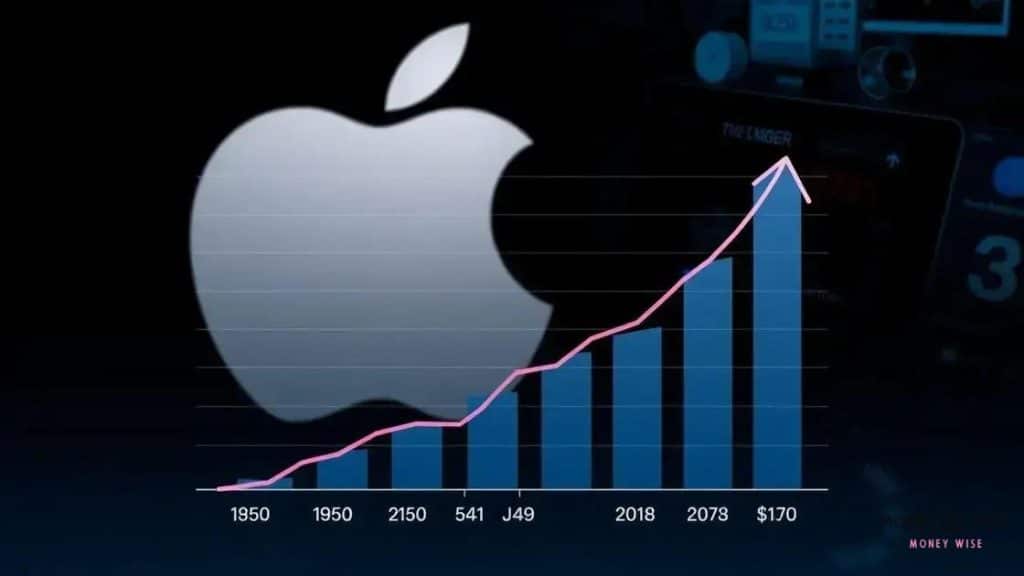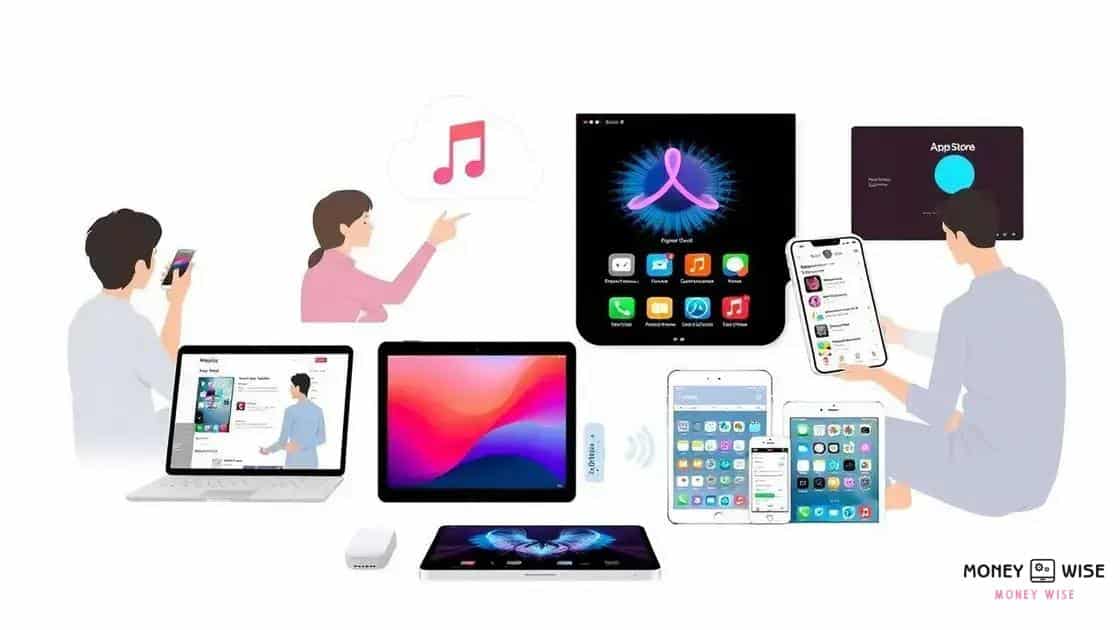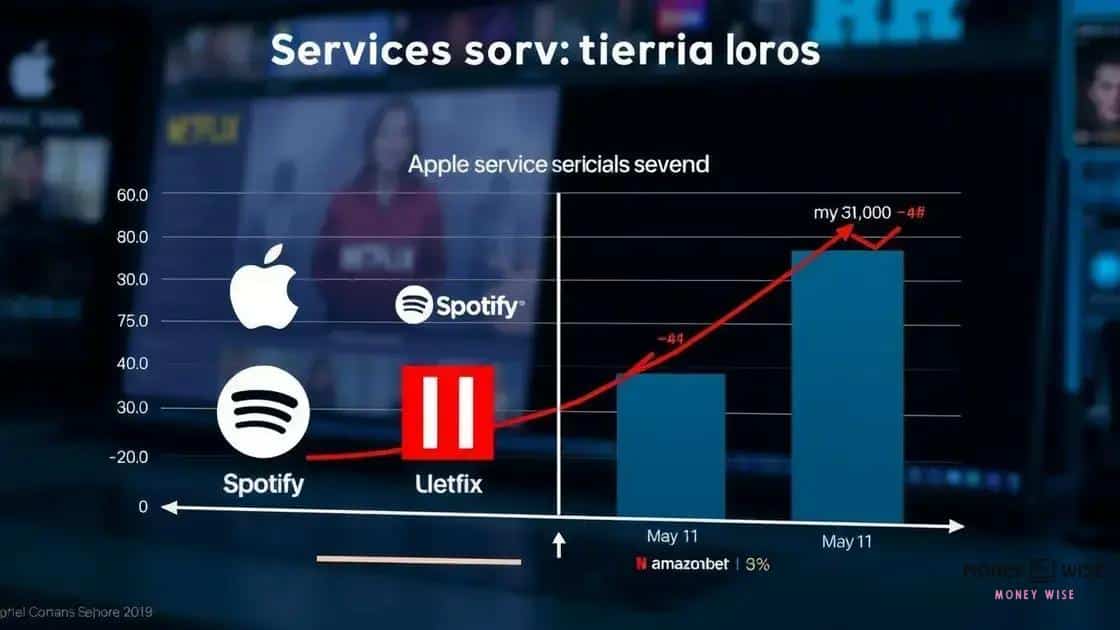Apple services revenue $26.34B Q1 2025 shocks analysts

Apple services revenue reached $26.34 billion in Q1 2025, driven by innovative offerings, a unified ecosystem, and strong customer loyalty while continuing to expand its market presence through emerging opportunities.
The news of Apple services revenue $26.34B Q1 2025 has surprised many in the industry. This impressive figure reveals not only the company’s strategic direction but also its ability to innovate within a competitive marketplace. Let’s dive into what this means for Apple and its users!
Understanding Apple’s service model
Apple’s service model is a significant part of its overall strategy. In recent years, the company has shifted its focus from hardware to a more diversified income source through its services. This transition demonstrates how companies can adapt in a rapidly changing tech landscape.
One of the key components of this model is the range of services Apple offers. These services include iCloud, Apple Music, and the App Store. Each service enhances the user experience and encourages customer loyalty. With each subscription, Apple generates consistent revenue, which is essential for long-term growth.
The Benefits of Apple’s Service Model
There are several advantages that come with Apple’s service model:
- Diverse Revenue Streams: Unlike many companies, Apple does not rely solely on hardware sales.
- Increased Customer Loyalty: Services create a deeper connection between Apple and its users.
- Scalability: Apple can easily add new services without the need for significant infrastructure changes.
- Data Insights: Apple gains valuable insights from user engagement with their services.
Another critical aspect is how Apple integrates these services into its existing ecosystem. By doing so, it ensures a seamless experience for users across devices. For instance, Apple Music works flawlessly with iPhones, iPads, and MacBooks. This interconnectedness not only gives consumers more value but also encourages them to stay within the Apple ecosystem.
Competing in the Service Market
In a competitive market, standing out is crucial. Apple has managed to carve out its niche through premium services and unique offerings. Many competitors struggle to keep pace with Apple’s innovation and brand loyalty.
As Apple expands its service offerings, they continue to explore new opportunities for growth. The integration of services into daily life positions Apple as more than just a hardware company; it becomes a vital part of users’ digital lives.
Understanding Apple’s service model helps visualize its impact on revenue and growth. By focusing on services, Apple not only capitalizes on its extensive user base but also sets the stage for future innovations that can further boost its market presence.
Key contributors to Apple services revenue

Several key factors contribute to the impressive growth of Apple’s services revenue. Examining these contributors reveals how they play a vital role in the company’s overall success.
One major aspect is the sheer breadth of Apple’s service offerings. From iCloud storage to Apple Music, each service appeals to various user needs. This variety not only attracts new customers but also encourages existing customers to engage more with Apple.
Top Factors Driving Revenue
Here are some top contributors to Apple’s services revenue:
- Subscription Growth: Subscription services, such as Apple Music and Apple TV+, have seen significant increases in users.
- App Store Sales: The App Store generates hefty revenues through app purchases and in-app transactions.
- Cloud Services: iCloud provides users with storage solutions that continuously draw funds through monthly subscriptions.
- Customer Loyalty: The cohesive ecosystem keeps users coming back for more, solidifying ongoing revenue.
The integration of these services within the Apple ecosystem enhances user experience. For example, they work seamlessly across devices like iPhones, iPads, and Macs. This interconnected environment fosters a sense of loyalty and encourages users to explore more products and services.
Additionally, Apple invests heavily in advertising and marketing for its services. By promoting features and benefits, the company captures the attention of potential customers and retains existing users. This marketing strategy not only showcases the value of services but also highlights their necessity to users’ daily lives.
The Role of Innovation
Innovation is crucial to keeping services relevant in a competitive market. Regular updates and new features ensure that Apple is always a step ahead. As the market evolves, so do Apple’s services, appealing to changing consumer preferences.
In essence, the growth in Apple services revenue stems from a combination of diverse offerings, strategic marketing, and consistent innovation. By focusing on these key areas, Apple solidifies its financial future while providing valuable services to its users.
Impact of subscription services on Apple’s bottom line
Subscription services have greatly influenced Apple’s financial success, becoming a fundamental part of their business model. These services provide steady revenue streams, which is crucial for maintaining stability and planning future growth.
By focusing on subscription-based offerings like Apple Music and Apple TV+, Apple has tapped into a vast market of users seeking content and cloud services. This approach not only attracts new users but also keeps existing customers engaged, boosting overall profitability.
Benefits of Subscription Services
Here are some key benefits subscription services bring to Apple’s bottom line:
- Predicable Revenue: Subscriptions ensure a consistent monthly income, providing financial predictability.
- User Retention: Subscriptions create loyalty, as users are incentivized to stick with the service to gain ongoing access.
- Cost Efficiency: It is often cheaper for users to subscribe than to pay upfront for services, making it more appealing.
- Upselling Opportunities: Subscribers may be more likely to try additional services Apple offers.
Moreover, strong marketing strategies have contributed to the success of these subscription services. Apple effectively promotes the value of its offerings, successfully persuading customers to sign up. Features such as exclusive content and seamless integration across devices enhance the appeal.
When looking at the broader context, the impact of these services extends beyond immediate revenue. They enhance Apple’s brand and create a lasting ecosystem that encourages customers to invest in more than just hardware. As customers rely on multiple subscriptions, they are less likely to switch to competitors.
The Future of Subscription Services
As technology evolves, Apple continues to innovate its subscription services. The company actively seeks feedback from users, allowing them to adapt and introduce new features that meet changing demands. This dedication to improvement positions Apple favorably in the competitive market.
The substantial impact of subscription services on Apple’s bottom line highlights their importance in the company’s overall strategy. By effectively leveraging these services, Apple not only boosts profits but also fosters customer loyalty.
Comparing Apple services revenue with competitors

Comparing Apple services revenue with its competitors reveals the company’s impressive standing in the tech industry. Apple has established itself as a leader in services, consistently outperforming rivals.
In the realm of subscription services and digital content, Apple competes with companies like Spotify, Netflix, and Amazon. Each of these companies has its unique offerings, but Apple’s ability to integrate services into its ecosystem provides a significant advantage. Users appreciate the seamless experience across devices, which enhances customer loyalty.
Key Comparisons
Here are some critical points where Apple distinguishes itself:
- Diverse Offerings: Apple provides a wider range of services, including iCloud, Apple Music, and Apple TV+, catering to various needs.
- Unified Ecosystem: Apple’s services work together flawlessly, creating a convenience that competitors struggle to match.
- Customer Retention: The integration of services into everyday devices enhances user retention rates, which is crucial for maintaining consistent revenue.
- Brand Loyalty: Apple enjoys a strong reputation and customer trust, making users more likely to engage with its services over competitors.
While companies like Spotify have seen substantial growth in music streaming, Apple’s service model goes beyond just one category. The combination of music, video, and cloud storage generates a broader revenue potential. This strategy helps Apple maintain a competitive edge.
Moreover, competitive pricing strategies play a role in how each company attracts users. Apple’s subscription prices are often comparable, but the additional value provided through its ecosystem encourages users to choose Apple over alternatives.
Market Growth and Trends
As the market evolves, it’s essential to keep track of trends that affect revenue. Apple consistently adapts to changes, or user preferences, and competition, ensuring the services remain relevant. With a strong focus on innovation, Apple can respond quickly to market demands.
Overall, examining Apple’s services in relation to its competitors highlights its strengths and ongoing commitment to enhancing the user experience. This competitive edge ensures that Apple remains a dominant player in the technology industry.
Future outlook for Apple services expansion
The future outlook for Apple services expansion appears promising. As the demand for digital services continues to rise, Apple is well-positioned to capitalize on this trend.
One of the main strategies for future growth is the ongoing enhancement of existing services. Apple regularly updates its platforms, ensuring they meet users’ needs and expectations. This commitment to improvement keeps users engaged and encourages subscription renewals. With regular feature updates, Apple Music and Apple TV+ become increasingly appealing to customers.
Opportunities for Growth
Several opportunities appear on the horizon for Apple in the services sector:
- New Service Offerings: Apple may introduce innovative services or products to capture new market segments.
- Global Expansion: By entering emerging markets, Apple can reach a broader audience, particularly in regions where smartphone penetration is increasing.
- Partnerships and Collaborations: Collaborations with other brands or content creators can enhance service value and drive subscriber growth.
- Focus on Privacy and Security: Apple’s strong emphasis on user privacy could become a distinguishing factor as consumers become more privacy-conscious.
As users seek more seamless experiences across their devices, integrating services into a unified ecosystem becomes increasingly crucial. Apple can leverage its ecosystem to drive growth by offering bundled services at competitive prices.
Innovation will play a significant role in Apple’s strategy for the future. By investing in technology and exploring emerging trends, Apple can stay ahead of competitors and continue to attract new customers.
Adapting to Market Changes
Being adaptable is key to flourishing in the fast-changing tech landscape. Apple needs to be attentive to consumer preferences and industry trends. Staying informed about competitors and the overall market will help Apple refine its approaches.
In summary, the future outlook for Apple’s services expansion includes continued innovation, new offerings, and a commitment to enhancing user experiences. By focusing on these areas, Apple can maintain its competitive edge and ensure ongoing success in the digital services market.
FAQ – Frequently Asked Questions about Apple Services Revenue
What drives Apple services revenue growth?
Apple services revenue grows due to a combination of diverse offerings, customer loyalty, and continuous innovation in its digital products.
How does Apple compare its services to competitors?
Apple stands out with a unified ecosystem, integrating services seamlessly across devices, while competitors like Spotify and Netflix offer single-category services.
What opportunities exist for Apple’s services in the future?
Future opportunities include expanding into emerging markets, introducing new services, and enhancing existing ones to meet changing consumer demands.
How important is customer loyalty for Apple?
Customer loyalty is crucial for Apple as it encourages users to engage with multiple services, ensuring steady revenue and reducing churn.
What role does innovation play in Apple’s service strategy?
Innovation is critical for keeping services relevant and attractive to users. Apple invests in regular updates and new features to enhance user experience.





